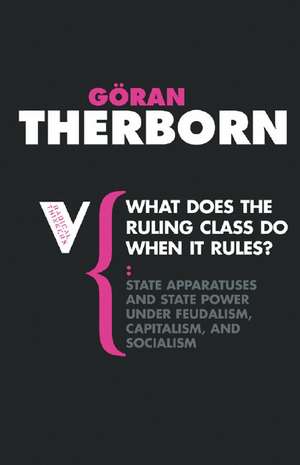What Does the Ruling Class Do When It Rules?: Radical Thinkers Set 03
Autor Goran Therbornen Limba Engleză Paperback – 17 ian 2008
Preț: 115.40 lei
Nou
22.08€ • 23.01$ • 18.28£
Carte disponibilă
Livrare economică 13-27 martie
Specificații
ISBN-10: 1844672107
Pagini: 288
Ilustrații: black & white illustrations
Dimensiuni: 129 x 197 x 23 mm
Greutate: 0.32 kg
Editura: VERSO
Seria Radical Thinkers Set 03
Notă biografică
Göran Therborn holds the Chair of Sociology at the University of Cambridge, and is editor and author of Inequalities of the World, Asia and Europe in Globalization, Between Sex and Power and From Marxism to Post Marxism?
Recenzii
“An extremely thought-provoking, wide-ranging book.”—Comment
"Excellent ... With a dispassionate and erudite command of wide-ranging historical and comparative sources, this book is essential reading."--"Choice""An extremely thought-provoking, wide-ranging book."--"Comment"
Descriere
In his new book, Göran Therborn – author of the now standard comparative work on classical sociology and historical materialism, Science, Class and Society – looks at successive state structures in an arrestingly fresh perspective. Therborn uses the formal categories of modern system analysis – input mechanisms, processes of transformation, output flows – to advance a substantive Marxist analysis of state power and state apparatuses. His account of these is comparative in the most far-reaching historical sense: its object is nothing less than the construction of systematic typology of the differences between the feudal state, the capitalist state and the socialist state. Therborn ranges from the monarchies of mediaeval Europe through the bourgeois democracies of the west in the 20th century to the contemporary regimes in Russia, Eastern Europe and China. The book ends with a major analytic survey of the strategies of working class parties for socialism, from the Second International to the Comintern to Eurocommunism, that applies the structural findings of Therborn’s enquiry in the ‘Future as History’. Written with lucidity and economy, What Does the Ruling Class Do when it Rules? represents a remarkable sociological and political synthesis.




















